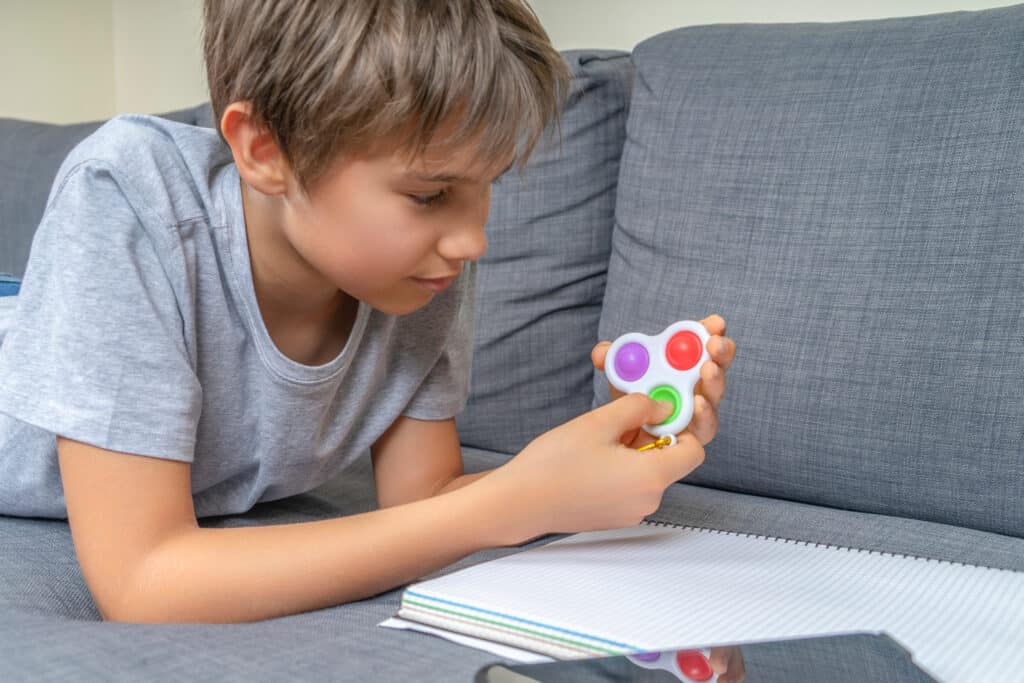Homeschooling a Child with ADHD
Attention-deficit/hyperactivity disorder (ADHD) is one of the most common learning disabilities, with 7% of children affected by the condition. ADHD affects executive functioning, which can impact attention, organization, planning, and beginning new tasks.
ADHD can present unique challenges, but the right tools and programs can provide essential support for students. Sometimes, a little extra support can be all a child needs to flourish. In this article, we will explore some strategies and tips for helping your child learn with ADHD.
How Does ADHD Affect Learning?
Learning is both exciting and challenging, and all students occasionally hit barriers to success. Children with ADHD are no different, although they may face different challenges.
ADHD affects executive functioning, which impacts self-regulation, working memory, and cognitive flexibility. With support, students diagnosed with ADHD can …
- Better direct their fidgeting
- Complete tasks
- Be better organized
- Keep track of their materials
- Better self-regulate when tackling an activity or facing an unfamiliar/disruptive sound
- Patiently wait their turn
- Better focus
Providing your child with the right tools and environment can allow them to learn without all the distractions of a classroom.
Is it better to homeschool a child with ADHD?
Sometimes, the traditional classroom setting can be too limiting for students with ADHD. Some parents have found success in home education, where they can provide accommodations that the classroom cannot.
While there are definitely some benefits to homeschooling, you may want to consult with a specialist, such as a clinical psychologist, before making a decision.
Some benefits include…
Flexibility and Individualization
Families can have a flexible homeschool schedule and curriculum that can be tailored to each child’s specific needs and learning style.
Safe and Comfortable Environment
Homeschooling can provide a safe and comfortable environment for the child with ADHD. This can help them feel more at ease and reduce distractions.
No Stigmatization
Homeschooling can help children with ADHD avoid feeling excluded or singled out. At home, they may not be labeled as different from their peers, which may happen in a traditional school setting.

Tips for Supporting a Child with ADHD
There is no perfect guide on how to teach a child with ADHD. Keep in mind that some approaches may work well for some but not others.
At Miacademy, our staff includes educators with a wide range of experiences. For this article, we met with one of our talented curriculum developers, Anna Kubetin!
Anna has 11 years of experience working with students with ADHD, and she directed the PreK-12th grade Learning Support Services department during a previous career. She also worked with the undergraduate Learning Disabilities Program at Northeastern University to help college-aged students find the best strategies for their needs.
Here, she’s shared some of her strategies for students with ADHD:
Create a routine, but allow for flexibility.
“Structure! Having something to create expectations can really help students with ADHD. Predictability, timers, knowing ‘how long I can work before I need a break’ is really important,” Anna suggests.
It’s good to establish a regular schedule but to also be open to change. Schedules and timers can keep students motivated. It also helps if students “chunk” their time instead of working for one long eight-hour block.
Reduce distractions, and take breaks often!
Take breaks often to reduce brain fatigue. Knowing how long your student can work for can help you plan breaks. Anna says that “A good rule of thumb is for every year, 2-5 minutes of work. For example, a seven year old may work between 14-35 minutes before they need a break.”
A timer counting down to a break can motivate some children with ADHD. If you can incorporate movement into your breaks, all the better! Plan for movement breaks throughout the day, or try to keep them active while learning. This could be reading while bouncing on a yoga ball, using a fidget band on their chair, or using other types of fidget toys while learning.
In addition, putting phones in a different room or using browser extensions can help students focus. These extensions block new tabs from being opened for a set amount of time to decrease distractions. There are also phone apps that disable social media during study time to prevent any scrolling out of habit, especially if the student needs to use technology for the activity.
Help your student prioritize to prevent task paralysis.
“One strategy to fix task initiation [is to] pick your favorite subject or easiest subject first,” says Anna.
Sometimes, having a bunch of tasks and not knowing where to start can be intimidating! Helping your student prioritize can prevent task paralysis. Younger students often need help with this, so it can be good to organize tasks by time sensitivity or importance.
An example of this may be to do science homework first, then work on reading. If learning to read is a struggle, then completing science before can act as a “brain warm-up.” By the time your student begins their reading, they already have one subject completed for the day!
Play to your strengths.
ADHD brains are wired differently, which can give your child some unique abilities! Your student may experience periods of hyperfocus and increased creativity, empathy, and intuition. Many people with ADHD can be described as very kind, persistent, and innovative individuals.
For example, if your student often experiences hyperfocus, see if you can incorporate it into your routine. Anna notes that “Especially with students with ADHD, sometimes catching periods of peak focus can be super helpful, especially for planning high-priority or difficult tasks.” Anna also mentioned that incorporating more hands-on, creative activities can be a stimulating change from textbooks or computers during learning.
How Miacademy Can Help Students With ADHD
At Miacademy and MiaPrep, we strive to create an engaging learning environment for all students. We offer a high-quality, accredited curriculum across many subjects. Here are some features that are great accommodations for students with ADHD:
1. Flexibility
One of the most important things you can provide for your student is flexibility. When they can decide what to work on and when, they may be able to focus for longer. This is especially true when they have a break to look forward to.
At Miacademy, we design all our curricula with flexibility in mind. Students have access to all lessons across all grade levels and can complete lessons in any order they choose. They can also create their own schedule to optimize their learning experience. Miacademy is able to meet students where they are and help them grow from there.
2. Learning Materials
Our course offers high-quality extensions, instructional videos, practice activities, and assessment quizzes. Students have a variety of ways to interact with the curriculum and practice what they’ve learned! The majority of core subject lessons come with PDF notes for students to follow along with, which is especially helpful for students with ADHD. Our guided notes are designed to help students synthesize the main ideas of each lesson without getting bogged down in details.
3. Accessibility and Learning Management Tools
Our lessons offer built-in text-to-speech capability, closed captions, flexible due dates, educational games, automatic grading, and comprehensive report generation features. These features help students learn however works best for them and help parents manage their homeschool records seamlessly.
4. Games, Social Opportunities, and More!
Miacademy isn’t just a learning platform but also a community. Our site includes a moderated social platform where students can share educational videos, create art, and interact with others safely. Miacademy’s unparalleled customization and flexibility can be incredibly valuable when starting your homeschool journey. Sometimes, all your student needs to excel is a little extra support! For more information about how our online homeschool curriculum can support you and your child, contact our friendly customer service team!
FAQs:
What is the best homeschool style for ADHD?
There is no “one size fits all” approach to student success. Many parents who homeschool a child with ADHD can confirm this! However, for students with ADHD, a homeschool curriculum generally works best when it…
- Is customizable to fit the student’s strengths
- Is tailored to support their needs
- Provides tools to keep them motivated
- Provides tools to improve their social skills
Can ADHD be improved?
The cause of ADHD is unclear, and it doesn’t go away. However, there are many different strategies that ADHD learners can use to make their learning more efficient. For people with ADHD, learning about and employing creative strategies can create a large impact on daily life. It’s important to find out what works best for your student, as each case of ADHD is different.
How do students with ADHD learn how to read?
In both the traditional classroom and homeschooling environments, ADHD can pose huge challenges for students learning to read. For additional tips and tricks, check out our resource on how to teach a student with ADHD how to read.
Updated: 10/20/2023
